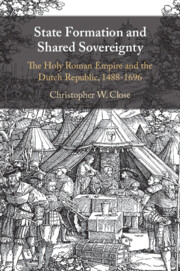Book contents
- State Formation and Shared Sovereignty
- State Formation and Shared Sovereignty
- Copyright page
- Contents
- Maps
- Acknowledgments
- Abbreviations
- Maps
- Introduction
- 1 The Swabian League and the Politics of Alliance (1488–1534)
- 2 Alliances and the Early Reformation (1526–1545)
- 3 Alliances and New Visions for the Empire and the Low Countries (1540–1556)
- 4 Shared Sovereignty and Regional Peace (1552–1567)
- 5 Shared Sovereignty and Multi-confessionality in the Empire and the Low Countries (1566–1609)
- 6 Religious Alliance and the Legacy of Past Leagues (1591–1613)
- 7 Religious Alliance and the Thirty Years’ War (1610–1632)
- 8 Westphalia and Politics of Alliance in the Empire and the Dutch Republic (1631–1696)
- Conclusion
- Bibliography
- Index
7 - Religious Alliance and the Thirty Years’ War (1610–1632)
Published online by Cambridge University Press: 02 March 2021
- State Formation and Shared Sovereignty
- State Formation and Shared Sovereignty
- Copyright page
- Contents
- Maps
- Acknowledgments
- Abbreviations
- Maps
- Introduction
- 1 The Swabian League and the Politics of Alliance (1488–1534)
- 2 Alliances and the Early Reformation (1526–1545)
- 3 Alliances and New Visions for the Empire and the Low Countries (1540–1556)
- 4 Shared Sovereignty and Regional Peace (1552–1567)
- 5 Shared Sovereignty and Multi-confessionality in the Empire and the Low Countries (1566–1609)
- 6 Religious Alliance and the Legacy of Past Leagues (1591–1613)
- 7 Religious Alliance and the Thirty Years’ War (1610–1632)
- 8 Westphalia and Politics of Alliance in the Empire and the Dutch Republic (1631–1696)
- Conclusion
- Bibliography
- Index
Summary
Chapter 7 examines the causes of the Thirty Years‘ War through the lens of the Protestant Union and Catholic Liga. While each alliance’s smaller Estates successfully imposed their vision on the larger Estates in the early 1610s, internal conflict in the Union and Liga resurfaced almost a decade later at the start of the Thirty Years‘ War. The Union’s inability to resolve the internal differences that first crystallized in 1610 proved decisive in its defeat and dissolution in 1621. Conversely, the Liga’s ability to balance the visions of its leading territory, Bavaria, with the alliance’s smaller ecclesiastical states explains its military success. The Liga’s capacity for serving the interests of all members underscores how it supported Bavaria’s expansion as a territorial state, maintained the integrity of its smaller member states, and influenced the development of the Empire’s political system during the war. This chapter therefore reevaluates the causes and course of the Thirty Years‘ War through the politics of alliance. It shows that the religious and constitutional impulses driving the war were in many cases inseparable for the parties involved.
Keywords
- Type
- Chapter
- Information
- State Formation and Shared SovereigntyThe Holy Roman Empire and the Dutch Republic, 1488–1690, pp. 245 - 286Publisher: Cambridge University PressPrint publication year: 2021

